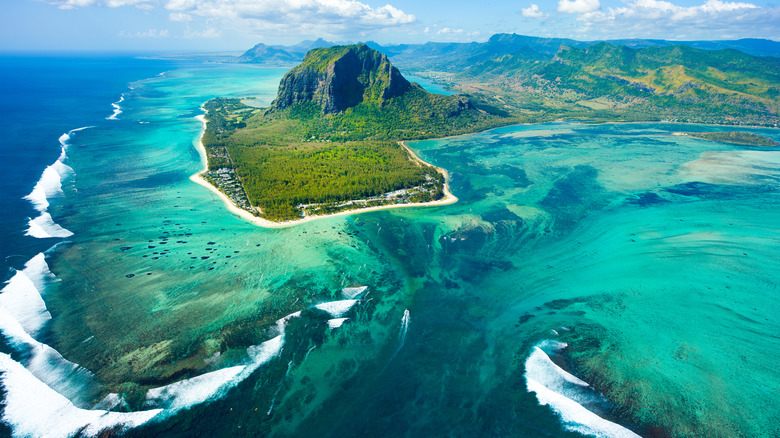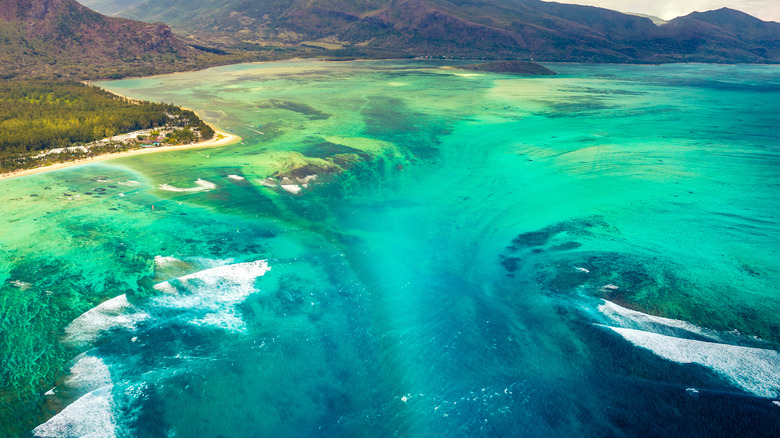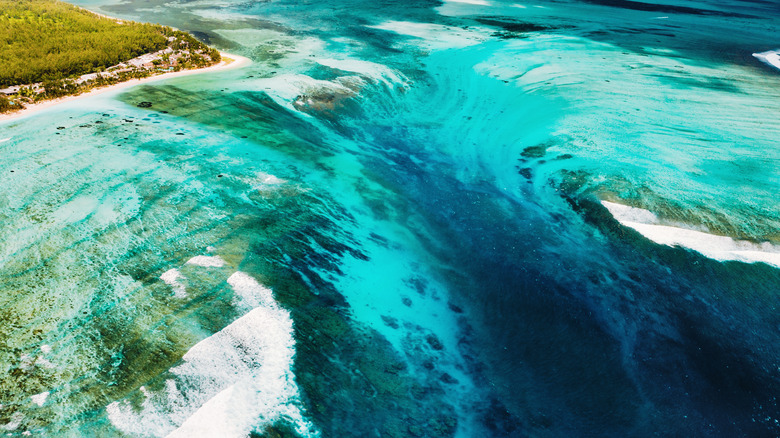The Stunning Optical Illusion Of Mauritius' Underwater Waterfall
Waterfalls are a favorite go-to spot for hikers and sightseers of all stripes. Giant, colossal waterfalls like Niagara Falls in Canada and the U.S., Victoria Falls in Zimbabwe, and Angel Falls in Venezuela tend to get a lot of attention for their awe-inspiring size and immense, roaring power. On the other hand, small, local, hidden falls feel like a happy secret shared between an intrepid explorer and the natural world. Some people just like to stand in silence at waterfalls and soak up all the details, some might venture under the downpour for a bit of excitement, and others might strike a glamour-shot pose in front of the falls for profile picture purposes. But an underwater waterfall? That would be a sight to see indeed.
Folks hoping to get a glimpse of such a phenomenon in person will have to make the trek to Le Morne Brabant peninsula on the little island of Mauritius in the Indian Ocean east of Madagascar, itself is east of Mozambique, Africa. Mauritius is a small, independent island nation of about 1.3 million people and is comprised of a bunch of islands and archipelagoes, of which Mauritius Island is the main island. All of these islands stick out of the top of a vast oceanic plateau that includes Madagascar. So the "underwater waterfall"? It's not really a waterfall — it's more of a sandfall. Sand and silt are sliding off the edge of the plateau and down 2.5 miles into the depths of the ocean.
The edge of an oceanic plateau
The underwater waterfall at Mauritius Island — it doesn't have a specific name — gets its unique appearance wholly because of its location and the clarity of its waters, which allow folks to see topographical contours beneath the surface. As Big Think explains, the waterfall is located on the very southern tip of Mauritius Island, which is located at the southern edge of the Mascarene Plateau. Like a plateau on land — think Ayers Rock in the Australian outback — the Mascarene Plateau rises steeply on all sides to a flat surface on top. Parts of that flat surface stick up a bit farther than others. Those are the islands of Mauritius.
Typically, depths like that found at the bottom of Mauritius' underwater waterfall exist far away from the coast. If you stand on a beach and start to walk into the ocean, the land underneath your feet tends to slope down gently into the water. There'll be some drop-off somewhere, but it'll take some time to hit a severe precipice. Take Florida: its "outer continental shelf" rests just over 10 miles off the coast. But in the case of Mauritius Island, its continental shelf is a stone's throw away from the coast. And if you're thinking that this sounds pretty dangerous and that the currents at Mauritius' underwater waterfall can suck you down to your death, have no fear — The Discoveries Of says that it's completely safe for swimming, diving, boating, etc.
Deep beauty meets deep history
The peninsula next to Mauritius' underwater waterfall, known by the Dutch name "Le Morne Brabant" from the region's old colonial days, was dubbed a UNESCO World Heritage Site in 2008. As UNESCO says, the area is "a symbol of the slaves' fight for freedom, their suffering, and their sacrifice," speaking of enslaved peoples who were marooned on the peninsula and used its mountain as a kind of refuge. This history dates back to the region's first visit by Dutch explorer Wybrant Warwijck in 1598. Visitors don't have to be aware of this stuff to admire and enjoy the area's gorgeous natural landscapes, but knowing such background adds a layer of depth beyond mere aesthetics.
And yes, Mauritius Island, Le Morne Brabant, and its underwater waterfall have become a small but glittering spot for intrepid travelers willing and financially able to make the journey. Sites like Trip Advisor and Culture Trip detail multiday tour packages, rugged treks up Le Morne mountain, swanky resort stays, horseback riding and kiteboarding opportunities, and more. Port Louis, the capital of the nation of Mauritius and main city on Mauritius Island, is about a 75-minute drive from Le Morne Brabant. The city affords a truly charming contrast to the area's famous underwater waterfall and adds yet another layer of depth to the island's eye-catching optical illusion spanning down toward the ocean floor deep below.


